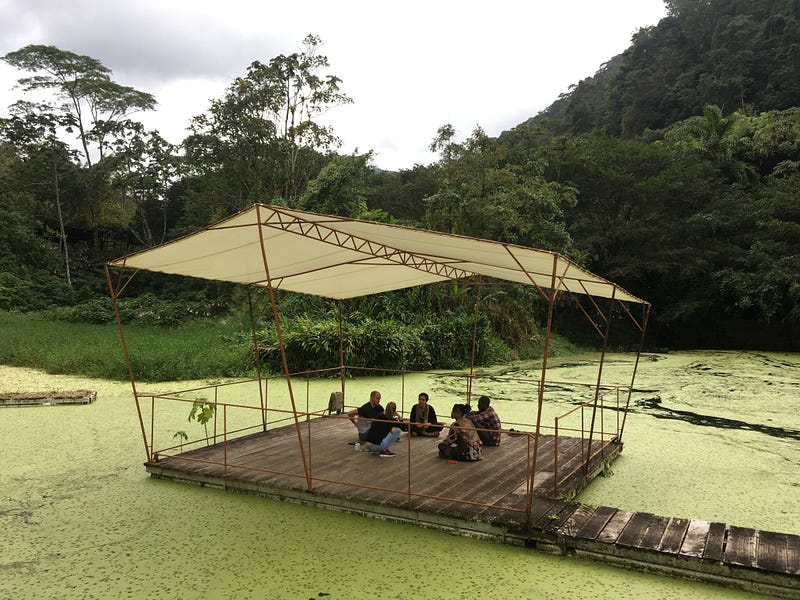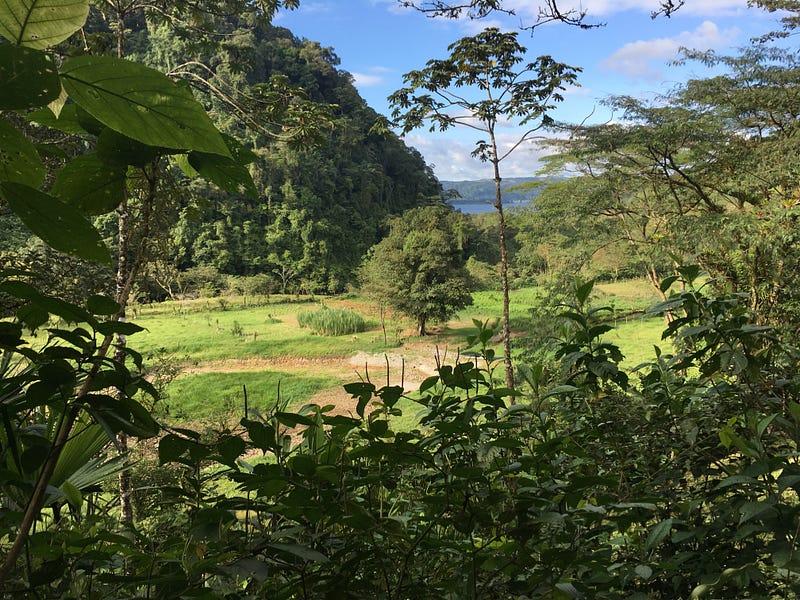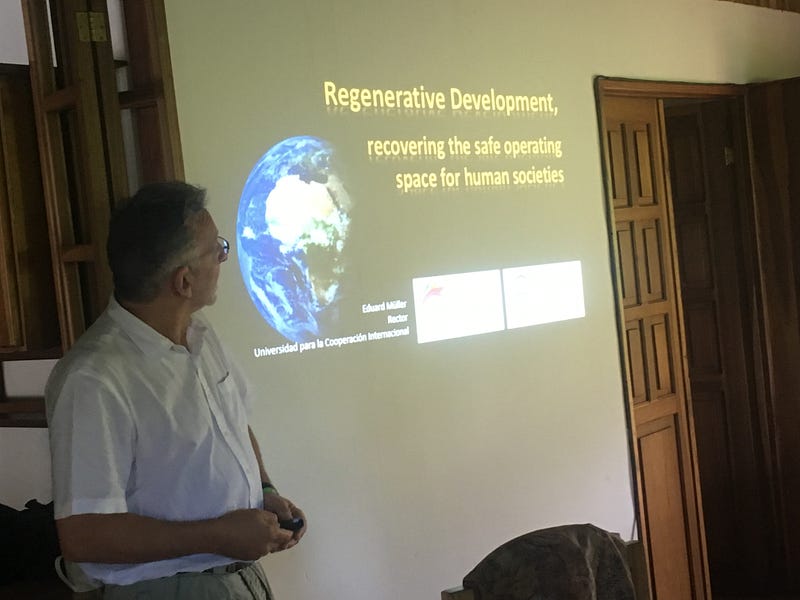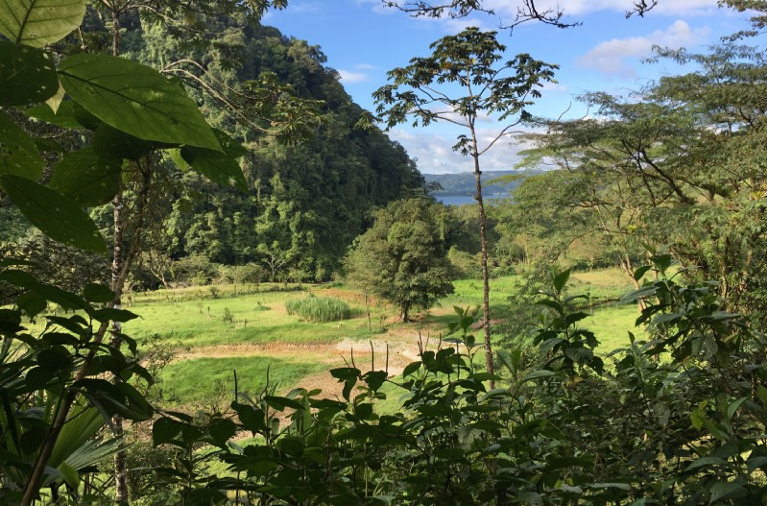Last week, I gave a five day workshop on “Managing Planetary Collapse” at a retreat center in northern Costa Rica. The participants came together to earnestly grapple with the converging crises that define these times — while learning how to be more hopeful and impactful with insights about how the current predicament came into being.
This essay is written as a summary of what we covered to help spread what we are doing here and stimulate discussions more broadly. Our plan is to offer the workshop again later this year. Yet we realize that many will not be able to join us in person and this topic is relevant to a much larger number of people. In the spirit of sharing, I write these words to encourage readers to take up your own conversations in earnest about the state of the world and where we are all going as a species in the midst of unprecedented global change.
Day 1: Framing the Topic and Creating Community
We began the workshop by facilitating a group-formation process informed by the design principles discovered by Elinor Ostrom about how to manage common-pooled assets. This included sharing the personal intentions and aspirations of all participants to reveal a common purpose and shared values. It also involved the formulation of social norms and rules-of-play for how we should behave together as a group.
From here we found the basis for trust and cooperation that would be needed to tackle a topic like planetary collapse. I took an hour of the first morning to outline (a) that planetary collapse is so large, multi-faceted, and complex that the human mind cannot fully grasp it; and (b) that it has been emerging for much longer than most people realize.
In my own inquiries about this topic (spanning roughly 20 years), I have learned that today’s challenges first took root long ago in our ancestral line when early hominids — who weren’t Homo Sapiens yet — began altering their landscapes in ways that shaped the course of evolutionary history.
 Participants deep in a group discussion about how to manage the complexities of global change
Participants deep in a group discussion about how to manage the complexities of global change
To give you a flavor of what I mean, consider the following:
- Early hominids gained the power of conceptual metaphor more than 2 million years ago, enabling them to see spears and knife edges in jagged rocks. This externalized chewing onto the environment and made more nutrients available for growing healthy bodies and large brains.
- From that time until now our ancestors participated in the “social alteration” of landscapes to bring even more nutrients and energy to hominids at the expense of other species.
- Bring agriculture into the scene (roughly 10,000 years ago) and social organization of economic productivity begins to grow rapidly for modifying landscapes to serve humans while ecosystems degrade around us.
- This has been the basis of collapse for all civilizations — in one form or another — between then and now. What has changed since the industrial revolution is that we have grown to planetary scales.
Without going into more details about the various collapse patterns unfolding in the world now, we can already see that planetary collapse is much more complex and long-range in time than most people realize. Much harm has already occurred. Some collapses have already transpired within the larger global pattern. And more collapses are still unfolding that converge into the global wave of change ensuing over the last century and next several decades.
This is a lot to take in!
From here we went on to discuss how human beings create “layers of semantic interpretation” between our minds and the world — such that information flows may hold us in mental models that are not adequately suited for the increasing complexities of the real world. Realizing this opened a pathway for discussing the social scripts and stereotyped narratives most of us adopted from our cultures that make us ill-equipped to deal with the challenges unfolding around us.
Day 2: Tour A Real-Life Circular Economy and Design of Culture
A great difficulty for most people is the struggle to ground global patterns in concrete ways that they can relate to with their bodies. We employed our legs and took a long walk around Rancho Margot — where the workshop was held — touring a “living laboratory” of circular economics and regenerative practices.
Together we learned how food can be grown locally in a healthy and sustainable manner. We visited the chicken coops, pigs birthing their babies, cattle eating meals from an actively managed food forest, all the while discussing how a retreat center and hotel grew up out of the rainforest around us to improve soils and increase biodiversity.

Walking the grounds of a working ranch based on regenerative ecological principles
The practical insights and hard-skilled business practices required to create a place like this gave us a context for mapping our concerns about global change to the rooting down in solid earth of human hands engaging in healing practices. We were participants in the design of a different kind of culture by living on the ranch during the workshop. And this opened us up to explore how we might “upscale” our efforts to design entire regional economies based on the same approaches.
In the afternoon, we introduced the topic of culture design as a way to apply knowledge and tools that serve humanity at necessary scales. A ranch is too small to make a measurable impact on its own. But a global network of ranches (or other regenerative sites) just might be up to the task!
This quickly opened up the Pandora’s Box of ethics and power relationships. Who is designing whom in the realms of intentional large-scale change?We unpacked the strategies used by a tiny elite group to enact upon the world their Neoliberal political agenda during the 20th Century — capturing the majority of governments and economies across the Earth in service to wealth hoarding and short-term greed.
We spent the rest of the day and part of the following morning on ethics, realizing that we could talk about it for the entire time we had together and still have issues left unresolved.
Day 3: Planetary Boundaries and Regeneration for Entire Bioregions
One of the participants at our workshop was Eduard Müller — founder and president of the University for International Cooperation. He gave a presentation about the ways to measure overshoot-and-collapse using the planetary boundaries framework developed by Stockholm Resilience Centre.
He took us through the concepts we would need to (a) measure planetary health; (b) map it to the functioning of national economies; and (c) create targets for regenerative design across social and ecological metrics.

Eduard Müller outlining our global pathway to recover planetary health
We built on this foundational knowledge to spend the afternoon working on bioregional efforts in four countries — Costa Rica, Guatemala, Kenya, and Nigeria — where participants have existing relationships that can be catalyzed into action. While we didn’t get all the way to actionable outcomes in a single afternoon, this was an important time for practicing the kinds of collaborative inquiry that will be necessary in the decades to come.
Day 4: Making Decisions in Your Own Life
Having spent three days on larger topics, we brought it back down to the human scale and asked the question “How do I make big life decisions in times like these?” We introduced the framework of cultural scaffolding to make visible how our lives are shaped by support structures (or their absence) during critical developmental periods.
What are the supports that you have now? How will your life change if you step away from them? Are the supports you need available in some way that you hadn’t realized before? Will you do this alone or with your family? These questions and more kept coming up for us as we engaged in quiet inquiry on our own and participated in group discussions throughout the day.
Day 5: Summaries and Next Steps
It had been an intense learning process for several days. So we wrapped up on the fifth day with summaries of all that we had covered and an “Offers and Needs Exchange” to reveal how we could help each other take practical steps that lead to action.
It was clear all along that talking alone would be insufficient. Action is needed. People will need to make big changes in their lives. And we are not well equipped to do it on our own. So we will need to depend on each other.
The trust built up over several days of meaningful conversation opened our hearts to the ways we can help each other succeed. A global network of regenerative projects must take form, spread and flourish, if we are to have any chance of managing the collapse processes unfolding all around us.
Time will tell if we have prepared enough. This workshop marks the beginning for the School of Applied Cultural Evolution that will offer many new educational experiences in the future. As I mentioned at the beginning, we will offer this workshop again. Plans are also underway to host workshops on bioregional design, the regeneration of human capacities. regenerative economics, community governance, and other topics that will come up as we develop our programs.
For now, I merely wanted to share what we accomplished together in our first program.
Onward, fellow humans.





